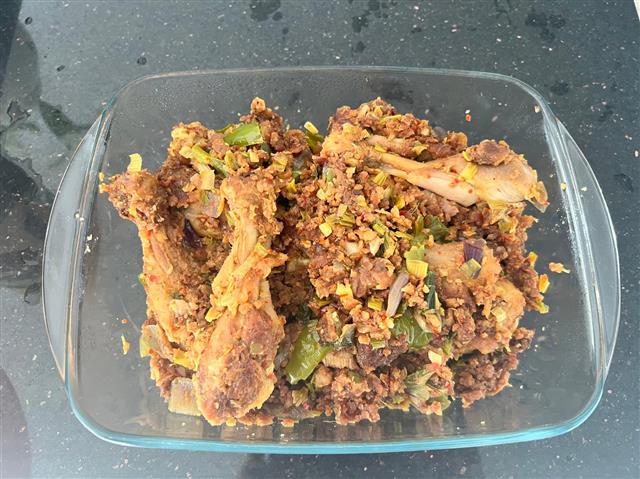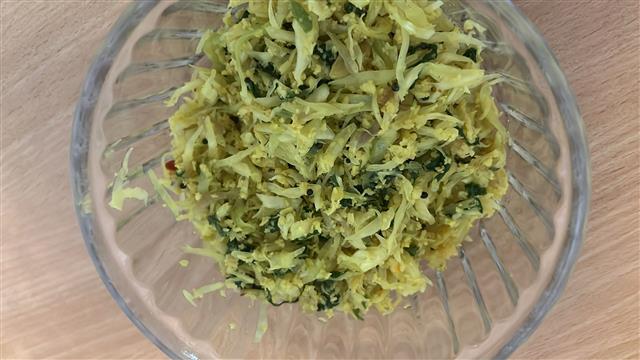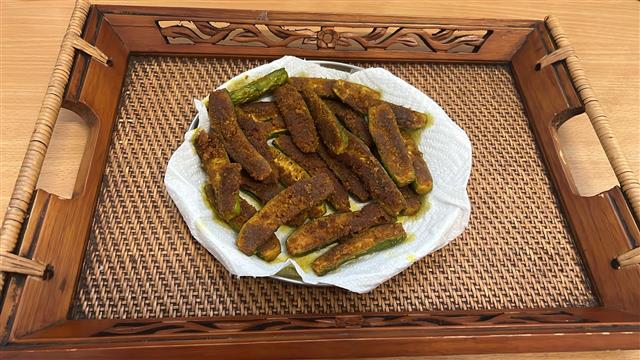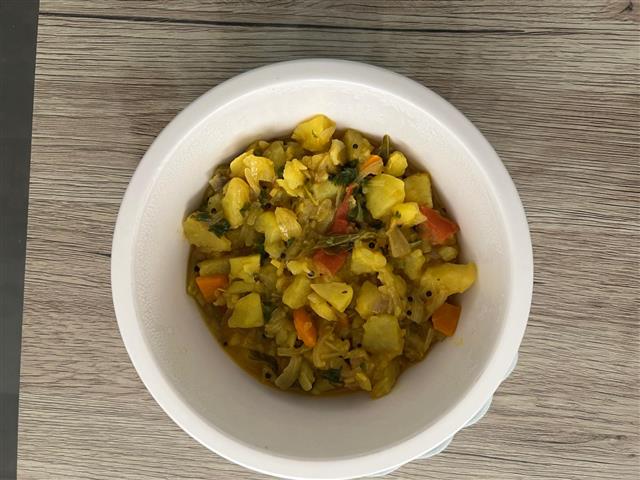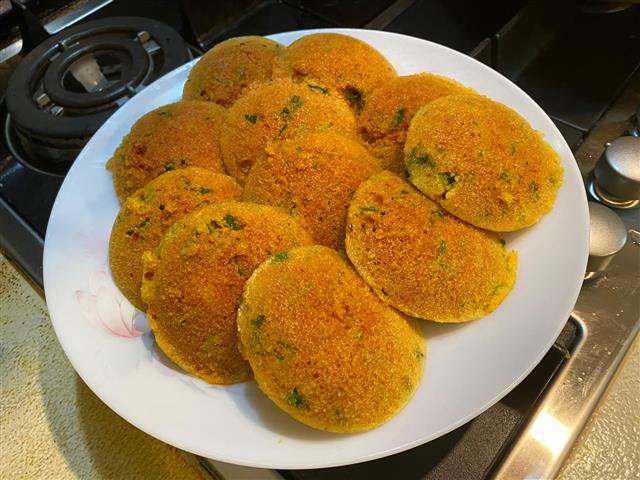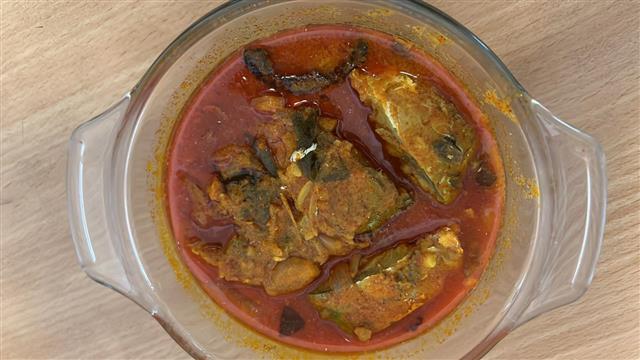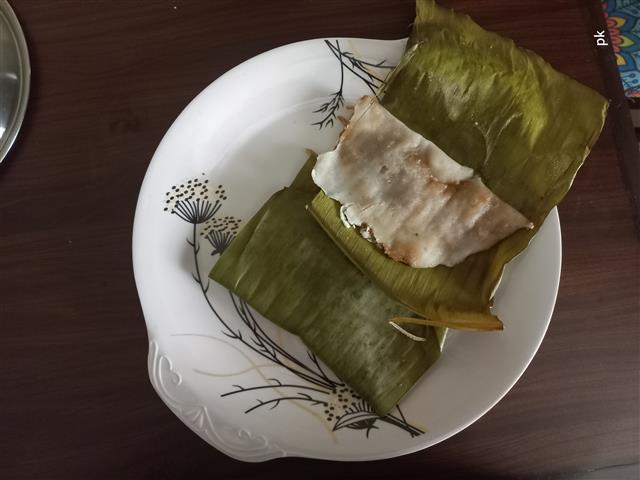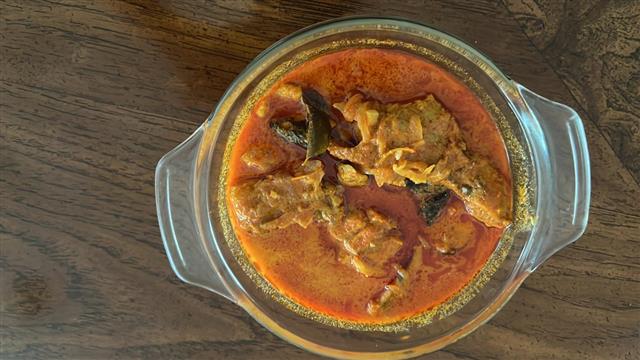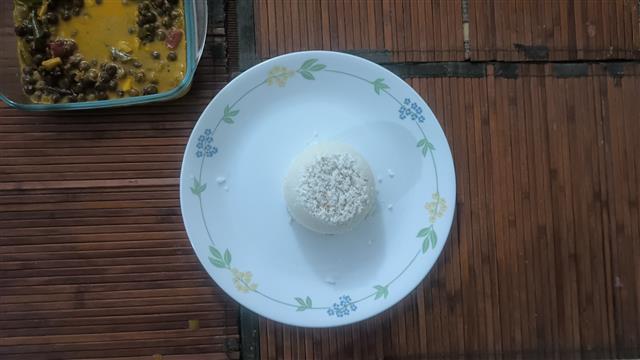
Chembu Moru Curry
(4 reviews)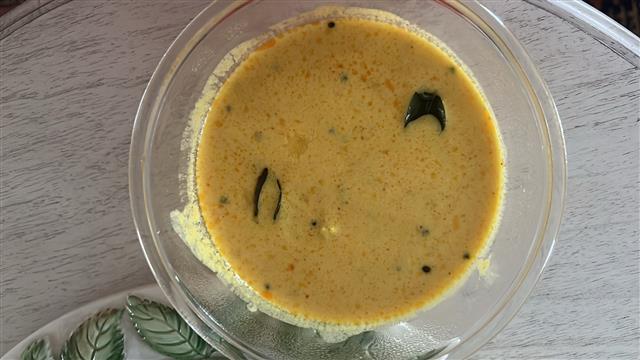
Chembu Moru Curry is a mildly spiced, curd-based curry made with taro root, coconut, and tempering spices.
It's part of the wider family of Kerala moru curries, but has its own identity thanks to the creamy chembu.
Served with rice, it makes a wholesome curry that feels both light and satisfying.
Ingredients
Directions
- Take small chembu (Taro root), peel them and cut them into 2 pieces. Chop the shallots and set aside. Grind together the coconut, shallots, and cumin seeds with a little water.
- Boil water in the saucepan or kadhai and cook them. The water should cover the taro pieces. Once cooked, drain the water.
- Add some more water in the same pan along with turmeric powder, 1/2 teaspoon chilli powder, and salt, and continue to cook the taro.
- Add the coconut mixture and beaten curd into the curry. Mix well and cook for 2 to 3 minutes. Turn off the flame.
- In a small frying or tempering pan, add coconut oil, mustard seeds and fenugreek seeds. After the seeds splutter, add red chilli powder, curry leaves, and some salt.
- When the curry leaves have crisped up, add the tempering to the cooked chembu.
Cooking Tips
• Rinse the taro well before peeling the skin.
• To save time, cook taro or chembu in a pressure cooker for 2 or 3 whistles.
• Use fresh curd or slightly sour curd depending on your preference. Avoid curd that's too watery.
• Never boil after adding curd, as it can split or curdle.
• Check chembu while cooking asovercooked taro turns mushy and sticky.
• Tempering tip: Always turn off the stove before adding red chilli powder to prevent burning.
How to Serve
• With Steamed matta rice (red rice)
• With Dosa or appam for a lighter meal
• With Pappadam or banana chips for texture
• With Potato Mezhukkupuratti or Beetroot Thoran
• With Fish fry or Njandu Curry
The Story Behind Chembu Moru Curry
Chembu Moru Curry reminds me of the kind of lunch you eat slowly. It's often what we make when there's not much left in the fridge but a few root vegetables and curd.
Back home, chembu was dug out from the backyard during the monsoon. The earth would cling to its skin, and we'd wash it multiple times before peeling.
It's not a glamorous vegetable. My mother used to say it "settles the stomach". The dish is simple, but when that hot red rice soaks up the moru, and you get a chunk of soft chembu in your mouth, it feels perfect.
How Chembu Moru Curry Stands Apart
Though it belongs to the family of Kerala-style moru curries, Chembu Moru Curry is noticeably different in texture and flavour. Moru Kachiyathu is a spiced buttermilk curry with no vegetables (or sometimes just ash gourd), and Manga Moru Curry uses mango for sharp, fruity tang,
Chembu Moru Curry on the other hand is a starchy curry using tubers. The s taro root thickens the curry naturally, giving it a creamy mouthfeel. It's less tangy than mango-based versions and creamier than Moru Kachiyathu.
Taro Root in Kerala Cuisine
Known locally as chembu, taro root is a much-loved tuber in Kerala households. It's especially popular during the monsoon months, when its warming nature makes it ideal for light curries and steamed dishes.
Whether it's cooked into a chembu puzhukku, added to kaalan, or featured in a simple stir-fry, taro brings a creamy, sticky texture that absorbs spices beautifully. Chembu is also believed to aid digestion when cooked properly.
In Chembu Moru Curry, the taro root isn't just a filler but the soul of the dish. It balances the sourness of the curd and the richness of the coconut.
Ingredient Swaps for Taro Root
If you can't find taro root, you can try a few alternatives that offer a similar soft texture and creaminess.
Yam (Chena): Slightly firmer and earthier, but works well with moru-based gravies.
Potato: A neutral less sticky alternative to chembu.
Raw banana (Vazhakka): Has a firm body and mild flavour, and works with coconut-curd bases.
Colocasia stem (Arbi or Chembila): Has a similar earthy taste but is more fibrous. Better when you use small pieces or chopped small.
Remember, that each of these swaps changes your curry.
Regional Variations
Across Kerala, Chembu Moru Curry takes on subtle changes based on local preferences.
In Central Kerala, families may add a slit green chilli to the coconut grind for a spicier finish. The curry is usually thickened well and paired with hot matta rice.
In Southern regions, a little more coconut is often used, and sometimes a drizzle of raw coconut oil is added at the end for aroma.
In Malabar, it's less common, but home cooks prefer a thinner curry without fenugreek seeds.
Regardless of where it's made, Chembu Moru Curry always holds its place as a delicious classic!
Pro Tips for Perfect Results
→ Choose young and small chembu. They're less fibrous and cook evenly.
→ If unsure about chembu's doneness, poke with a fork. It should go through cleanly.
→ For a smooth curry, beat the curd before using it.
→ Add the tempering in the end to preserve the freshness and texture
→ Let the curry rest 5–10 minutes after tempering for a deeper flavour.
Chembu Moru Curry Variations
- With Garlic and Ginger
Add a crushed garlic pod and a slice of ginger to the tempering.
- With Green Chilli
Add a slit green chilli to the coconut paste for more heat.
- Without Coconut
Some families skip the coconut entirely and use only curd for a leaner version.
- With GInger
A tiny piece of ginger can be added while cooking chembu for added flavour.
- Low-spice
This is naturally mild, but you can skip chilli powder while cooking taro and use only in tempering.
Diet-Friendly Adaptations
• Low-carb Version – Use French or broad beans or cauliflower instead of tubers.
• Vegan Version – Use plant-based yogurt or coconut milk for a dairy-free version.
• Low-Fat Version– Use low-fat curd and skip oil in tempering.
Storing & Reheating Tips
→ Refrigerate: This curry keeps well for a day or two.
→ Reheat: Never boil but reheat gently on low flame. Alternatively, place the container in a bowl of hot water to gently bring it to a warm temperature.
→ Freeze: Don't freeze as this changes the curd's texture.
Common Mistakes to Avoid
→ Adding curd over high heat. It will cause splitting.
→ Overcooking chembu. It can become gluey and lose shape.
→ Using too little curd. Don't skimp unless adjusting to taste.
Frequently Asked Questions
- Can I make it in advance?
Yes, but it tastes best within a few hours of making. If preparing in advance, refrigerate and reheat gently.
- Can I use colocasia instead of taro?
Yes, but ensure it's the smaller variety (small Arbi) used in South Indian cooking.
- Is it necessary to use coconut?
Not always, but it adds a soft richness that pairs well with the chembu and curd.
- Can undercooked chembu cause an itchy throat?
Undercooked chembu can have calcium oxalates. Always cook it fully and avoid tasting raw.
Equipment Needed
→ Saucepan or Mann Chatti – to cook the taro and curry
→ Knife and chopping board – to cut taro and onions
→ Frying Pan – For tempering the spices
→ Blender or Mixer Jar – To blend onions coconut and cumin seeds
→ Wooden Spoon – For gently stirring
